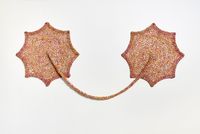
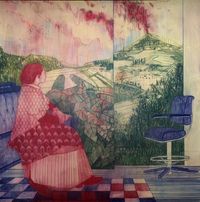
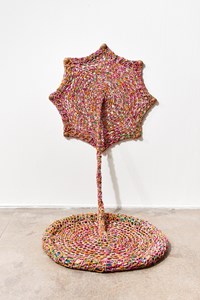
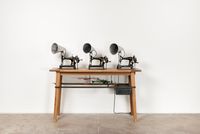
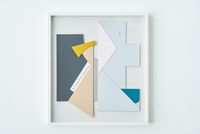
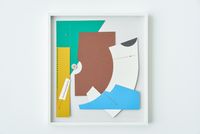
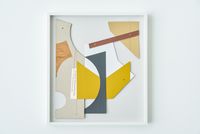
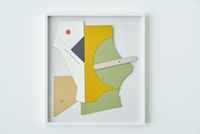
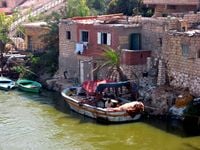

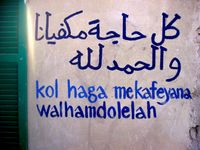
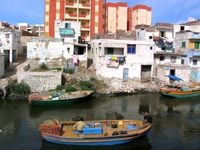
In a time of massive global environmental threats such as climate change, deforestation, loss of biodiversity, and global health threats, Goodman Gallery's South South presentation in Johannesburg considers the connection between planetary transformations and human agency in relation to our current geological epoch, known as the Anthropocene.
Referred to by some as the Capitalocene, this epoch has been defined by the impact of industrial development on the climate. This exhibition considers from a Global South perspective the impact of these human activities, tracing the historic and current extraction and exploitation of human and natural resources.
The title of the exhibition is taken from a project by Sue Williamson, titled What about El Max? El Max was a small fishing community in the city of Alexandria, Egypt where, until it was recently demolished, life was lived much as it had been for centuries. At the time of Williamson's project the community was under threat from the military stationed nearby which frequently interfered with fishing activities by closing the entrance from the canal to the sea.
A petrochemical company located at the top of the canal also wanted the community moved elsewhere because the fishermen complained about the water pollution caused by the company. While there, Williamson interviewed locals about life in El Max. Following this Williamson, together with her interviewees, settled on a statement which summed up their feelings about their community. This statement was painted on the walls of their houses, in English, in Arabic and in western alphabet Arabic. The signs were there for more than a decade until El Max was demolished.
Kiluanji Kia Henda's The Geometric Ballad of Fear is a series of nine photographs of idyllic landscapes on the Sardinian coast, between stacks, wild vegetation and the open sea. However, each photograph was superimposed on the structure of a grid, evocative of metal barriers of protection and repentance. The landscape scenarios, already anaesthetised by the choice of black and white, appear inaccessible and forced into the distance as if they were observed through a security barrier. The work evokes the walls and borders, physical and legal, with which the European continent has equipped itself in response to migration.
Yinka Shonibare's Hockey Sticks similarly considers migration from a historical standpoint. Created as part of a project with Meadow Arts and Hereford Cathedral, Shonibare incorporated the characters from the medieval Mappa Mundi on display in the cathedral itself to create depictions of medieval and contemporary cultural hybrids. These depictions explore what Shonibare refers to as, 'two of the most pressing concerns of our time, environmental protection and immigration. Inspired by the ability of the Mappa Mundi to still be reflecting our contemporary concerns of fear of the stranger or "other" which often leads to xenophobia. The depictions of extinct creatures of legend are a reminder that we may yet become extinct if we do not take care of our environment.'
Ernesto Neto describes his fabric works as 'resonating with the vibrations and energy of the earth's soil'. The works are made from traditional African and Brazilian textiles. In bringing these different materials together, Neto suggests how cultures develop and transform through globalisation and exchange, while still maintaining an inherent connection. By further interweaving organic shapes out of this fabric, the artist mimics the network of roots, soil and animals: lives which exist beneath the earth's surface and bring to mind the energy of the earth, 'from a historical, mineral, biological and spiritual point of view'.
William Kentridge's Untitled (Whispering in the Leaves) is taken from his three-channel projection, Notes Towards a Model Opera. Rooted in the extensive research into the intellectual, political, and social history of modern China, from Lu Xun to revolutionary theatre, the work explores dynamics of cultural diffusion and metamorphosis through the formal prism of the eight model operas of the Cultural Revolution.
Modernism as a colonial legacy is reflected in Yto Barrada's Reprendre Casa, Carrières Centrales, Casablanca. This series of photographs show trends in modernist urban development of the city, highlighting the failure of a universal model which did not take into account the needs and customs of the local population.
In Pamela Phatsimo Sunstrum's, Did you never think there would come a time?, a distant volcano can be seen erupting. This scene is contrasted by a seated woman, poised as she watches the impending doom of the volcano inching closer and closer to this seemingly safe reality. Sunstrum further heightens this tension by introducing a hole, or void, below the woman's feet, which the artist explains could pertain to 'the seeming stability of the ground and what happens when we thought to be solid is not solid at all and falls out beneath us.'
In Haiti, the conch (also called 'lambi', the name of the mollusc) is used in rural areas as a trumpet to signal the beginning of a meeting of the community. This call through the shell as an instrument is a very strong symbol in Haiti, having been used during the slave rebellion led by Francis Mackandal in 1791. Mackandal appealed to the African community in bondage through the conch, in order that they meet and free themselves.
Kapwani Kiwanga's glass conch is moulded on a conch from Haiti. The glass that is poured into the mould is obtained from Haitian sand. The process of transforming the sand into glass through fire is highly symbolic. Its violence evokes the inherent difficulty in the accessing of freedom, especially through the emblematic provenance of the material. Moreover, the tension present in the glass material, hard but fragile, in turn, echoes the notion of emancipation. Thus, the method of transformation and the characteristics of the materials are united in this work, suggesting a balance of power and fragility.
Misheck Masamvu uses painting as a way to show the 'breakdown of the pursuit of humanity'. His emotionally charged paintings express the artist's psychological state as he experiences the socio-political strife taking place in his home country. Masamvu, who studied at the Atelier Delta and Kunste Akademie in Munich, is influenced by the German Expressionist and Neo-Expressionist movements. His works consist of layered painted surfaces, abstracted forms and brushstrokes which are almost visceral and exist as remnants of the physical action of painting. One gets the sense that multiple temporalities have been included in one picture plane and that beneath the surface of one painted image, an infinity of others exists.
Mikhael Subotzky's Glossopteris takes its cue from Eduard Suess, a 19th century geologist, who is credited as the originator of the theory of Gondwana, a supercontinent that existed until the Jurassic period (about 180 million years ago) and consisted of two-thirds of today's continental area, including South America, Africa, Antarctica, Australia, the Indian Subcontinent, Zealandia, and Arabia. Suess based this theory on the discovery of fossilised ferns, Glossopteris, which were found both on the African and South American continents. This work is part of a series deconstructing the 'fathers' of various Western schools of thought and study.
Mateo Lopez's collage works form part of the ongoing series, 'The waste of my time', in which the artist repurposesunused materials in his studio. The latest works in this series were made in the artist's New York studio just before lockdown in 2020, using cardboard, acrylic paint and grommet. López draws inspiration from an anecdote on Josef Albers at Bauhaus Preliminary Class in 1923, which encapsulates his playful and pared-down approach.
Press release courtesy Goodman Gallery.
163 Jan Smuts Avenue
Parkwood
Johannesburg, 2193
South Africa
www.goodman-gallery.com
+27 117 881 113
+27 117 889 887 (Fax)
Tues - Fri, 8:30am - 5pm
Sat, 8:30am - 4pm